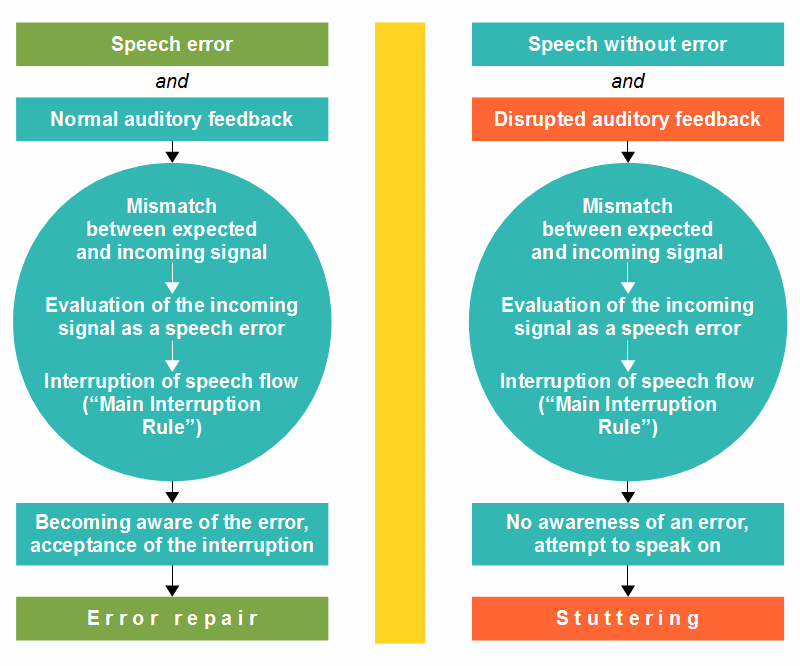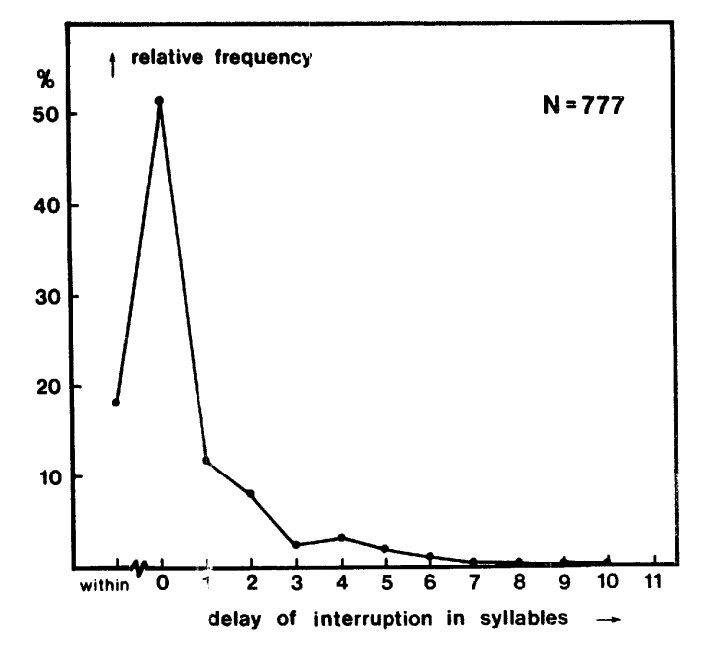 Theory of Stuttering – Blog
Theory of Stuttering – Blog
The Main Interruption Rule (MIR) is an important component of my theory of stuttering. It describes a speaker’s behavior when he (or his/her brain) detects a speech error. MIR was proposed by Willem Levelt in his essay “Monitoring and self-repair in speech” (1983) and again in his book “Speaking. From intention to articulation” (Cambridge 1989). There, on page 478, he puts MIR as follows:
"Stop the flow of speech immediately upon detecting trouble."
The figure below shows why MIR is important in my theory of stuttering: I assume that the same interruptive mechanism is elicited when a real speech error is detected (A) and when an invalid error signal occurs because of insufficient processing of auditory feedback (B). In the latter case, the interruption results in stuttering when the speaker spontaneously tries to continue.

A ‘real speech error’ in the above figure must be defined as a mispronounced or mistaken word, that is, as a phonological error or a classical ‘slip of the tongue’,like “a cuf of coffee”. Phonological errors are relatively rare in speaking in one’s native language. The invalid error signals assumed in my theory resemble phonological errors, i.e., they are invalid phonological error signals : The internal monitoring system ‘believes’ that a phoneme sequence was produced incorrectly or incompletely.
When I included MIR in my theory I did not check if there were any new empirical findings regarding the interruption of speech after error detection. Meanwhile I caught up on, and here are the results. I found two studies of self-monitoring and error repair during speech, both in the journal Cognition: Blackmer and Mitton (1991): “Theoriesof monitoring and the timing of repairs in spontaneous speech” and Seyfeddinipur, Kita, and Indefrey (2008): “How speakers interrupt themselves in managing problems in speaking:Evidence from self-repairs”.
Blackmer and Mitton measured cut-off-to-repair intervals in spontaneous speech. They found many of these intervals to be very short (less than 100 ms, not rarely 0 ms), and they conclude that speakers often plan corrections while speaking and interrupt their speech not before this re-planning is finished, perhaps in order to avoid disfluent speech. Blackmer and Mitton deem such a behavior inconsistent with MIR which claims that speech, in a rule, is interrupted immediately after error detection.
Seyfeddinipur, Kita and Indefrey, however, reply: “The MIR can account for at least some zero ms cut-off-to-repair intervals if it is assumed that the interruption process itself takes time.” (838) During this reaction time, re-planning can already start and can, in simple cases, be finished at the moment of interruption. Therefore, MIR is quite consistent with short cut-off-to-repair intervals – especially if we not (as Levelt does) assume that every re-planning takes place in a separate “Formulator” module (see the discussion of Levelt’s model of speech production here in the main text).
An example of a repair with a zero ms cut-off-to-repair interval was “willfiddily/ fully” (Blackmer & Mitton, p. 190). In this case, the speech motor program of ‘willfully’ was correctly selected and started, but then, for unknown reasons, articulation switched to another motor program (‘fiddly’). The repair is here not a reformulation, but rather a back-switch to the original motor program.
The basic idea in this consideration is: In spontaneous speech, formulation and articulation are one process that is guided by the intended message (which develops and changes in the course of speaking) and by routines (of syntax, grammar, word use). There is a complicated interaction between these factors, which accounts for the high number of corrections in spontaneous speech: Blackmer and Mitton found that speakers made repairs once every 4.8 s on average. ‘Repair’ is however broadly defined here and includes, e.g., reformulations in order to be more clear or more appropriate as well as word repetitions in order to get more time for speech planning.
In the Blackmer and Mitton study, only 3% of all errors were production-based errors, that is, mispronounced or mistaken words (the rest was plan-based, that is, consequence of uncertainty in conceptualization or formulation, e.g., editing terns and repetitions together represented 72.9% of all errors). In the context of my theory of stuttering, however, only production-based errors are relevant. As mentioned above, the invalid error signals assumed in my stuttering theory are invalid phonological errors. It is therefore only interesting for us how people (or their brains) respond to real phonological errors – and phonological errors are a subcategory of production-based errors because a mispronounced word is a word produced, not an only planned one.
Seyfeddinipur, Kita, and Indefrey did not differentiate between production-based and other errors, but since they also used a broad definition of the term ‘repair’ (“a disfluency containing some indication of a speech suspension, e.g., a glottal stop, laryngalization, fillers, or silent pause greater than 200 ms, and a resumption in which there was a modification of the original delivery.” p. 839), the percentage of production-based errors might have been low in their material. It is hence not surprising that they came to the conclusion that “speakers interrupted themselves not at the moment they detected the problem but at the moment they were ready to produce the repair. Speakers preferred fluency over accuracy.” (837).
Astonishingly, they believe: “Speakers may interrupt themselves right away when they detect an expression with socially drastic consequences. By contrast, they may not interrupt themselves on detecting minor phonological errors such as a ‘cuf of coffee’.” (841). I don’t think so. When I feel I have said something inappropriate, I can decide whether or not I interrupt myself and make a correction. But in cases like “cuf of coffee” or in cases of grammatical errors I would automatically interrupt myself and make a repair. I think the worst case in speaking is the appearance someone does not master his native language.
Do I think so because I’m a stutterer? Vasic and Wijnen (2001;; 2005) proposed a theory in which they assume a hyper-sensitivity of stutterers’ self-monitoring for normal speech disfluencies. I don’t share this view (and I think their data doesn’t really support their theory (read more in Section 2.4 in the main text). However, I do believe that stutterers’ self-monitoring system is at least normally if not heightened sensitive to phonological errors (such as “cuf of coffee”) or phonological incompleteness. Someone who doesn’t detect such errors or who doesn’t respond to them with an interruption will, after my theory, hardly stutter because his/her brain will also hardly respond to invalid signals appearing like phonological errors.
Back to MIR: I think that both the studies discussed above are not very relevant in our context because of the the very broad definition of ‘error’ and the small percentage of production-based errors in the material (3% in Blackmer and Mitton, unknown but probably small in Seyfeddinipur et al.), thus these studies are not meaningful regarding the validity of MIR for production-based and especially for phonological speech errors. Let us now have a look at the data on the basis of which MIR was proposed. The figure below shows a diagram in Levelt (1983, p. 61). Levelt did not measure cut-off-to-repair times, but error-to -cut-off times. Note that the percentage of production-based errors in his material was 41.6%; thus these data are more meaningful for our concern.

Levelt measured the error-to-cut-off interval (delay of interruption) not in seconds but in syllables (horizontal axis). Vertically, the frequency in which the several delays occurred is shown. As one can see, immediate interruptions (0 syllables delay) were vastly most frequent.
Levelt’s results are confirmed by new data obtained by Martin Pfeiffer, published in his book “Selbstreparaturen im Deutschen. Syntaktischeund interaktionale Analyse” (Self-repairs in German. Syntactic and interactional analysis. Berlin 2015). Like Levelt, also Pfeiffer measured delays of interruption in syllables. Here the percentages of the several delays (Table7, p. 130):
0 syllables – 77.4%
1 syllable – 13.4%
2 syllables – 4.6%
3 syllables – 2.5%
4 syllables – 1.2%
5 syllables – 0.3%
6 syllables – 0.2%
7 syllables – 0,2%
8 syllables – 0.1%
Again, immediate interruptions were by far most frequent. Table 8, p. 132 in Pfeiffer's book shows that the delay of interruption does not depend on the type of repair (substitution, deletion, modifying insertion), which suggests that also the time needed for re-planning is not crucial for
the delay of interruption.
An important question in our context is that for a relationship between delay of interruption and type of error (phonological versus other errors). Table 72, p.281 in Martin Pfeiffer’s book shows delays of interruption depending on the linguistic level:
| Type of repair | Number | Mean delay |
| phonological | n = 58 | 0.12 syllables |
| semantic | n = 386 | 0.62 syllables |
| pragmatic | n = 41 | 0.58 syllables |
Pfeiffer writes: “There is a tendency to initiate phonological repairs especially quickly, whereas semantic and pragmatic repairs often are delayed.” (282, translated) So I think we can conclude that, at least for phonological errors, the Main Interruption Rule is not obsolete.
There is, however, a further problem: Blackmer and Mitton, Seyfeddinipur et al., and probably also Levelt believe that the interruption of speech after an error is the speaker’s decision, that is, a voluntary behavior. In my theory of stuttering, I assume that the interruption because of an invalid error signal is automatic and occurs independently from the speaker’s will. I will discuss this important issue in my next post in this blog.